Electric Guitar
 From Nwe
From Nwe 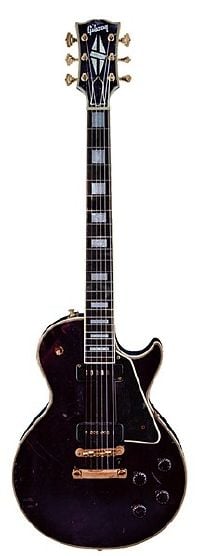 |
||||
|
An electric guitar is a type of guitar that uses pickups to convert the vibration of its strings into an electrical current, which is then made louder by an amplifier and a speaker. The signal that comes from the guitar may also be electronically altered with effects such as reverb or distortion.
The earliest electric guitars were hollow-bodied acoustic instruments with tungsten steel pickups made by the "Rickenbacker" company in 1931. These guitars were first used by Hawaiian-style, jazz, and country and western players.
By the late 1930s, noted jazz guitarists like Charlie Christian were using electric guitars in Swing-era big bands. Perhaps the first solid-body electric guitar was invented by guitar and recording innovator Les Paul, while the first commercially successful solid-body was the Fender Esquire, first marketed in 1950. The electric guitar was a key factor in the development of many musical styles that emerged since the early 1950s, such as Chicago blues, rockabilly, rock and roll, fusion, modern gospel music, and contemporary country. The instrument is also used in a range of other genres including New Age and some contemporary classical music.
Electric bass guitars, various electric slide guitars, and pedal steel guitars are also included in the category of electric guitars, and electric guitar technology has also been extended to a variety of other string instruments. The advent of electronic effects such as reverb, fuzz-tone, chorus, sustain, feedback, and echo opened the way for the electric guitar's often central role in hit records and performances from the late 1960s onward.
The application of electronic technology transformed the guitar from a chordal rhythm instrument and enabled it to become a lead musical voice of remarkable versatility and spiritual expressiveness.
Invention and early history
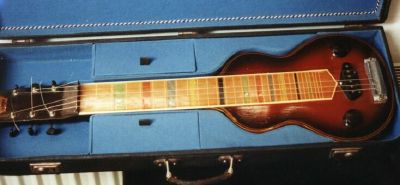

The need for an amplified guitar became apparent during the big band era, as jazz orchestras of the 1930s and 1940s increased in size, with larger brass sections. Some of the earliest true electric guitars adapted hollow bodied acoustic instruments and used tungsten pickups. This type of guitar was manufactured beginning in 1932, by Electro String Instrument Corporation in under the direction of Adolph Rickenbacher and George Beauchamp, the first model being built by Elctro craftsman Harry Watson. The company called the guitar the "Rickenbacker."
The earliest documented performance with an electrically amplified guitar was in 1932, by guitarist and bandleader Gage Brewer. The Wichita, Kansas-based musician had obtained two guitars—an Electric Hawaiian A-25 lap-steel and a standard Electric Spanish—from his friend Beauchamp. Brewer publicized his new instruments in an article in the Wichita Beacon, October 2, 1932, and through performances that month.
Early electric guitar manufacturers include: Rickenbacker in 1932; Dobro in 1933; National, AudioVox and Volu-tone in 1934; Vega, Epiphone, and Gibson in 1935; and many others by 1936.
The first recordings using the electric guitar were made by Hawaiian-style players such as Andy Iona as early as 1933. Bob Dunn of Milton Brown's Musical Brownies introduced the electric Hawaiian guitar to Western Swing music with his January 1935 Decca recordings. Alvino Rey brought the instrument to a wide audience in an orchestral setting and later developed the pedal steel guitar for the Gibson Company. An early proponent of the electric Spanish guitar was jazz guitarist George Barnes who used the instrument in two songs recorded in Chicago in March 1938. Another early recording was made in the same month by Eddie Durham with the Kansas City Five. Durham introduced the instrument to a young Charlie Christian, who made the instrument famous and is often thought of as the first electric guitarist, as well as being a major influence on jazz guitarists for decades thereafter.
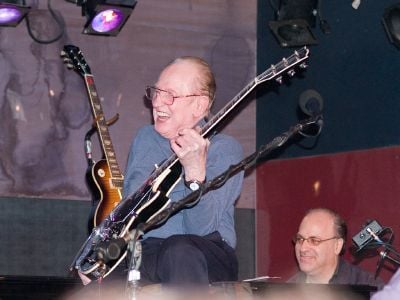
Other early proponents of the electric guitar on record include Jack Miller (Orville Knapp Orchestra), Les Paul (Fred Warring Orchestra), Danny Stewart (Andy Iona Orchestra), George Barnes (under many alias), Floyd Smith, Big Bill Broonzy, T-Bone Walker, George Van Eps, Tampa Red, Memphis Minnie, and Arthur Cruddup. The electric guitar was particular important in the development of Chicago-style urban blues in the early 1950s, and became a key feature of players like Muddy Waters, B.B. King, and John Lee Hooker.
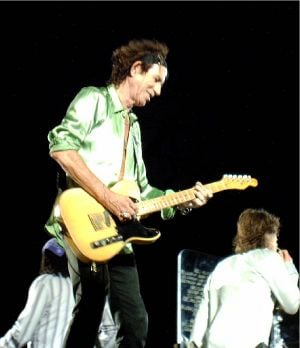
In 1941, Les Paul created the first solid-body electric guitar, and in 1946, Leo Fender designed the first commercially successful solid-body electric guitar. Using a single magnetic pickup, the model was initially named the "Esquire." It immediately found favor with country and western artists in California. The two-pickup version of the Esquire was called the "Broadcaster," which was soon changed to "Telecaster" due to a trademark issue.
The Telecaster became an industry standard and is still used by many musicians today. The original version included an ash body, a 25.5" maple neck, two single-coil six-pole pickups with tone and volume controls, a pickup selector switch, and an output jack mounted on the side of the body.
Fender is also credited with developing the first commercially successful electric bass guitar, called the Fender Precision Bass, introduced in 1951. In 1954, Fender introduced the Stratocaster, marketed as a deluxe model with several improvements and innovations over the Telecaster. Soon numerous other companies were producing solid-body electric guitars in competition with Fender. The most famous of these is the Gibson Les Paul model.
Types
Solid body
Solid-body electric guitars have no internal cavity or sound hole to accommodate vibrations as in acoustic guitars. They thus produce very little sound when played without amplification, but also tend to allow their strings to vibrate somewhat longer than hollow-body versions. Solid-body instruments are generally made of hardwood with a lacquer coating and have six steel strings. The wood is typically dried for three to six months in heated storage before being cut to shape. Pickups on the guitar convert the string vibrations into an electrical signal which is then fed to an amplifier and speaker.
Hollow body
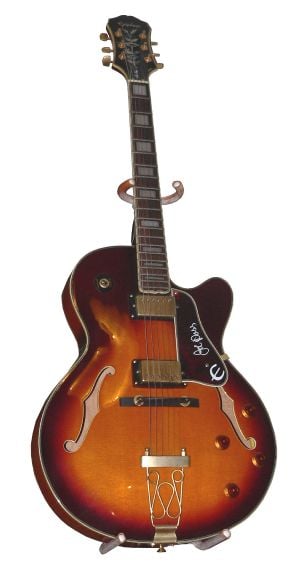
These guitars have a hollow body on which electronic pickups are mounted. They work in a similar way to solid-body electric guitars. A variant form, the semi-hollow-body guitar, strikes a balance between the characteristics of solid-body and hollow-body guitars. Typically, a semi-hollow body guitar will have a form more similar to a solid-body electric guitar, and may include two sound holes, one, or none. A small number of hollow-body guitars have used the unique acoustic/sustaining qualities of metal instead of wood.
Acoustic-electric
An increasing number of acoustic guitars are fitted with pickups as an alternative to using a separate microphone. They may also be fitted with a piezo-electric pickup under the bridge or with a low mass microphone (usually a condenser mic) inside the body of the guitar. In this case, the guitar is regarded an acoustic guitar rather than an electric guitar because the pickups do not produce a signal directly from the vibration of the strings.
String and neck variants
Both acoustic and electric guitars can be found with a variety of types of bridges and necks as well as various numbers of strings. The six-string guitar electric guitar is the most common, and 12-string versions are frequently used. The electric bass guitar usually has four strings, although a fifth is sometimes added to allow greater access to higher notes. Seven-string guitars are quite rare, and players have also experimented with various other numbers of strings.
Double-neck electric guitars enable players to utilize both a six-string and twelve-string configurations, or to use different tunings without switching guitars. They have also been used to achieve different pickup configurations, creating a variety of tonal effects. Pedal steel guitars often feature two necks, as well as two sets of corresponding pedals and pulleys.
Construction

The photo at the right shows the different parts of a typical electric guitar. The headstock (1) contains the metal machine heads which are used for tuning. The nut (2) is a thin fret-like strip of metal, plastic, or ivory with indentations to hold the strings in place at even intervals. The machine heads (3) are worm gears which the player turns to change the string tension and thus adjust the tuning. The frets (4) are thin metal strips which stop the string at the correct pitch when a string is pressed down against the fingerboard. The truss rod (5) is a metal cylinder used for adjusting the tension on the neck (not found on all instruments). Inlay (6) plays a simply decorative role. The neck and the fretboard (7) extend from the body to allow for fingering. At the neck joint (8), the neck is either glued or bolted to the body.
The body of the guitar (9) largely determines its unamplified sonic qualities. Typical woods include alder (producing a brighter, but well rounded sound), swamp ash (producing more pronounced highs and lows), mahogany (dark, bassy, warm), poplar (similar to mahogany), and basswood (considered neutral). Maple is also a popular body wood, producing a very bright tone, but is quite heavy. For this reason it is often placed as a "cap" on a guitar made up of primarily another wood.

In all of the above features, electric guitars do not differ greatly from traditional acoustic guitars. In the example here, the body (9) is made of wood which is painted and lacquered. However, some guitar bodies are made of polycarbonate or other materials. Pickups (10) are usually magnetic pickups, but may also be piezoelectric transducer pickups. Control knobs (11) are used to adjust volume and tone potentiometers. This guitar has a fixed bridge (12), but on some guitars, a spring-loaded hinged bridge called a "tremolo system" is used instead. This allows players to "bend" notes or chords up or down in pitch or perform a vibrato embellishment. A plastic pickguard (13) may be used used to protect the body from scratches.
Pickups

Compared with an acoustic guitar, electric guitars—especially solid-body types—make little audible sound simply by having their strings plucked. When an electric guitar is strummed, the movement of the strings generates (that is, "induces") a very small electrical current in the magnetic pickups, which are magnets wrapped with coils of very fine wire. That current is then sent through a cable to a guitar amplifier. The current induced is proportional to such factors as the density of the string or the amount of movement over these pickups. That vibration is, in turn, affected by several factors, such as the composition and shape of the body.
Because of their natural inductive qualities, all magnetic pickups tend to pick up ambient and usually unwanted electromagnetic noises. The resulting noise, the so-called "hum," is particularly strong with single-coil pickups. Double-coil or "humbucker" pickups were invented as a way to reduce or counter the unwanted ambient hum sounds. More recently pickups have been invented that detect string and body vibrations using infrared LED light.
Sound and effects
The electrical signal generated from an electric guitar to an amplifier may be "shaped" by using a range of effect devices or circuits that modify the tone and other characteristics of the signal. The most basic sound-shaping circuits are the volume and tone controls on the guitar itself and the gain and tone controls on the amplifier.
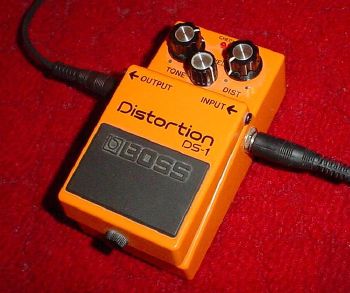
Reverb and tremolo effects were built into amps in the 1960s. In the late 1960s, guitarists began exploring a wider range of tonal effects by distorting the sound of the instrument. To do this, they increased the gain, or volume, of a separate preamplifier, which produced a "fuzz" tone. The wah-wah pedal was another modification that became popular in the late 1960s, enabling the player to adjust the tone control by using his foot, often to dramatic effect. Intentionally creating feedback also became a popular device during this period.
The tonal palette of the electric guitar was further modified by introducing an effects box. Traditionally built in a small metal chassis with an on/off foot switch, such "stomp boxes" have become an important part of the electric guitar tone in many genres. Typical effects include stereo chorus, fuzz, wah-wah and flanging, compression/sustain, delay, reverb, and phase shift.
In the 1970s, as effects pedals proliferated, their sounds were combined with power-tube distortion at lower, more controlled volumes by using power attenuators, autotransformer, and other techniques. By the 1980s and 1990s, digital and software effects became capable of replicating the analog effects used in the past.
In 2002, Gibson announced the first digital guitar, which performs analog-to-digital conversion internally, enabling direct interface with a computer through a standard Ethernet cable, eliminating cable-induced line noise and providing independent signal-processing for each string. In 2003 amp maker Line 6 released the Variax guitar, which uses piezoelectric pickups instead of the conventional electromagnetic ones and has an on board computer capable of modifying the sound of the guitar to model the sound of many instruments.
Uses
The advent of the electric guitar allowed guitars to be used as solo instruments in bands for the first time. The use of volume control also allows the guitar to switch easily from a rhythm instrument to a lead voice during instrumental solos. The electric bass guitar has made traditional double basses virtually obsolete in several genres.
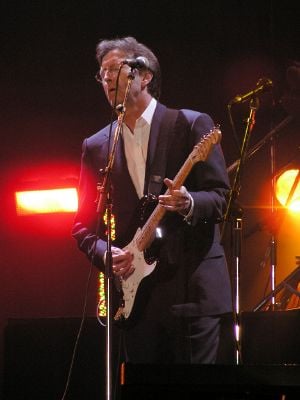
In the late 1940s and early 1950s, electric guitars gave birth to such diverse forms as Chicago blues, rockabilly, and rock and roll. They became featured instruments in the jazz field around the same time, although never reaching the dominance that they achieved in blues, country, and rock. Country music has made particular use not only of normal electric guitars and basses, but also of the electric pedal steel guitar, which was derived from the earlier lap steel guitars first popularized by Hawaiian-style musicians.
Beginning in the late 1960s, the new innovations in electric guitar techniques led to virtuoso performances by such players as Eric Clapton, Jimi Hendricks, and many later players. These musicians built on the blues styles of electric guitarists like Muddy Waters and B.B. King to express powerful new emotional and spiritual qualities with their instruments. In subsequent decades, new electronic technologies and experimental guitar designs opened the way to ever more creative uses of the electric guitar.
Classical composers began experimenting with the electric guitar in the 1960s and 1970s, but in the 1980s and 1990s, a growing number of composers, many of them also rock musicians, began writing contemporary classical music for the electric guitar. These include Shawn Lane, Steven Mackey, Nick Didkovsky, Scott Johnson, Lois V Vierk, Tim Brady, Tristan Murail, John Rogers, and Randall Woolf. Yngwie Malmsteen released his Concerto Suite for Electric Guitar and Orchestra in 1998, and Steve Vai released a double-live CD entitled Sound Theories, of his work with the Netherlands Metropole Orchestra in June 2007. The American composers Rhys Chatham and Glenn Branca have written "symphonic" works for large ensembles of electric guitars, in some cases numbering up to 100 players, and the instrument is a core member of the Bang on a Can All-Stars (played by Mark Stewart).
References
ISBN links support NWE through referral fees
- Bacon, Tony. The Fender Electric Guitar Book: A Complete History of Fender Instruments. New York, NY: Backbeat Books, 2007. ISBN 9780879308971.
- Carter, Walter. The Gibson Electric Guitar Book: Seventy Years of Classic Guitars. New York: Backbeat Books, 2007. ISBN 9780879308957.
- Freeth, Nick, and Charles Alexander. The Electric Guitar. Philadelphia: Courage Books, 1999. ISBN 9780762405220.
- Millard, A. J. The Electric Guitar: A History of an American Icon. Baltimore: Johns Hopkins University Press, 2004. ISBN 9780801878626.
- Ro, Lawrence. The Early Years of the Les Paul Legacy, 1915-1963. New York: Hal Leonard Books, 2008. ISBN 9780634048616.
- Waksman, Steve. Instruments of Desire: The Electric Guitar and the Shaping of Musical Experience. Cambridge, MA: Harvard University Press, 1999. ISBN 9780674000650.
External links
All links retrieved June 15, 2021.
- The Invention of the Electric Guitar
- How Electric Guitars Work
- Chicken Wing Solid Body Electric Guitar
Credits
New World Encyclopedia writers and editors rewrote and completed the Wikipedia article in accordance with New World Encyclopedia standards. This article abides by terms of the Creative Commons CC-by-sa 3.0 License (CC-by-sa), which may be used and disseminated with proper attribution. Credit is due under the terms of this license that can reference both the New World Encyclopedia contributors and the selfless volunteer contributors of the Wikimedia Foundation. To cite this article click here for a list of acceptable citing formats.The history of earlier contributions by wikipedians is accessible to researchers here:
- Electric guitar history
The history of this article since it was imported to New World Encyclopedia:
- History of "Electric guitar"
Note: Some restrictions may apply to use of individual images which are separately licensed.
↧ Download as ZWI file | Last modified: 02/04/2023 01:13:30 | 30 views
☰ Source: https://www.newworldencyclopedia.org/entry/Electric_guitar | License: CC BY-SA 3.0
 ZWI signed:
ZWI signed:
 KSF
KSF